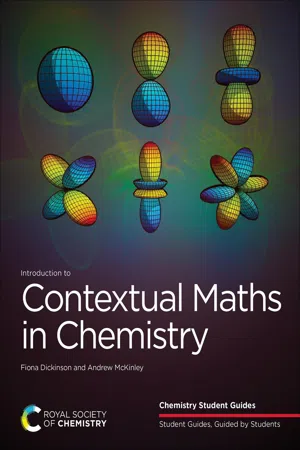
- 295 pages
- English
- ePUB (mobile friendly)
- Available on iOS & Android
Introduction to Contextual Maths in Chemistry
About this book
CHEMISTRY STUDENT GUIDES. GUIDED BY STUDENTS
For any student who has ever struggled with a mathematical understanding of chemistry, this book is for you.
Mathematics is the essential tool for physical scientists. We know that confidence in using mathematics early on in a chemistry degree builds a solid foundation for further study. However, applying the abstract mathematics taught in schools to chemical phenomena is one of the biggest challenges that chemistry students face.
In this book, we take a 'chemistry-first' approach. We link the mathematics to recognisable chemical concepts, building on high school chemistry, to facilitate deeper understanding. We cover the practical mathematical skills, including representation of data as tables and graphs, and give an overview of error handling in the physical sciences. More advanced mathematical concepts are introduced, using calculus to determine kinetic rate laws, intermolecular forces and in quantifying energetic change in thermodynamics. We also introduce the concept of the complex number and its role in considering quantum wave functions, widely used in computational chemistry.
There are worked examples and problem sets to provide plenty of practise material to build proficiency. We also include insights from real students, which identify common problem areas and provide the prompts that helped them to overcome these.
Chemistry Student Guides are written with current students involved at every stage, guiding the books towards the most challenging aspects of the topic.
Frequently asked questions
- Essential is ideal for learners and professionals who enjoy exploring a wide range of subjects. Access the Essential Library with 800,000+ trusted titles and best-sellers across business, personal growth, and the humanities. Includes unlimited reading time and Standard Read Aloud voice.
- Complete: Perfect for advanced learners and researchers needing full, unrestricted access. Unlock 1.4M+ books across hundreds of subjects, including academic and specialized titles. The Complete Plan also includes advanced features like Premium Read Aloud and Research Assistant.
Please note we cannot support devices running on iOS 13 and Android 7 or earlier. Learn more about using the app.
Information
CHAPTER

- □Notation of functions and inverse functions
- □Higher-order operations: powers, roots, exponentials and logarithms
- □Identifying inverse functions of higher-order operations
- □Strategies for using inverse functions to rearrange equations
- □Dimensional analysis: using units to validate equations and in combining quantities
- □SI base and derived units
- □Scaling factors: both SI and non-SI
- □Interconverting units and identifying a scaling factor
Why This Chapter Is Important
- There is a wealth of mathematical notation which we need to understand to apply the maths in a chemical context.
- The models we use in chemistry are fundamentally mathematical; understanding the mathematical relationships allows us to apply these ideas.
- All these models are represented as equations; being able to rearrange and manipulate them allows us to make predictions and to interpret experimental observations.
- Values are meaningless without a unit; having a consistent and systematic approach to the handling of units means that values can be shared and interpreted with no ambiguity, whether using SI units or quantities which are more manageable in a chemistry context, including dm3 and wavenumbers (cm−1).
- The process of dimensional analysis allows us to determine the appropriate units for our calculated quantities.

Table of contents
- Cover
- Title
- Copyright
- Author Biographies
- Student Contributors
- Preface
- Acknowledgements
- List of Symbols and Their Uses in Chemistry
- Table of Contents
- 1 The Basics: Mathematical Functions, Rearranging Equations and Handling Units
- 2 Probability and Statistics in Chemistry
- 3 Experimental Uncertainty and Significant Figures: What Are the Bounds of Experimental Error?
- 4 Tables and Graphs – Presenting and Analysing Experimental Data
- 5 Trigonometry and Coordinate Systems: Describing Molecular Positions
- 6 Vectors, Directions and Crystal Structures
- 7 Calculus 1, Differentiation: Mean Speeds and Equilibrium Separations
- 8 Calculus 2, Integration: Reaction Kinetics and Rate Laws
- 9 Complex Numbers: Quantum Mechanics and Solving the Schrödinger Equation
- Appendix: The Mathematical Toolkit
- Reading List
- Index